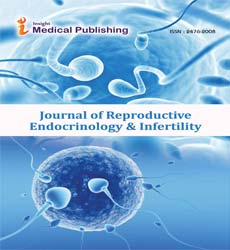Endocrine Disrupting Chemicals and Their Impact on Human Fertility and Reproductive Health
Brolinson Niels*
Department of Obstetrics and Gynecology, Stanford University School of Medicine, Stanford, California
Published Date: 2025-02-28Brolinson Niels*
Department of Obstetrics and Gynecology, Stanford University School of Medicine, Stanford, California
Corresponding author:
Brolinson Niels,
Department of Obstetrics and Gynecology, Stanford University School of Medicine, Stanford, California,
E-mail: brolinson@niels.edu
Received date: February 01, 2025, Manuscript No. ipjrei-25-20619; Editor assigned date: February 03, 2025, PreQC No. ipjrei-25-20619 (PQ); Reviewed date: February 15, 2025, QC No. ipjrei-25-20619; Revised date: February 22, 2025, Manuscript No. ipjrei-25-20619 (R); Published date: February 28, 2025, DOI: 10.36648/ipwhrm.10.1.66
Citation: Niels B (2025) Endocrine Disrupting Chemicals and Their Impact on Human Fertility and Reproductive Health. J Reprod Endocrinol Infert Vol.10 No.1: 66
Introduction
Endocrine disrupting chemicals (EDCs) are exogenous substances capable of interfering with the bodyâ??s hormonal signaling pathways, leading to adverse developmental, reproductive, neurological, and immune effects. These chemicals, commonly found in pesticides, plastics, industrial byproducts, and personal care products, mimic or block natural hormones such as estrogens, androgens, and thyroid hormones. Their pervasive presence in the environment and ability to bioaccumulate raise serious concerns about their long-term effects on human fertility and reproductive health, making them a growing public health priority [1].
Description
One of the primary mechanisms by which EDCs affect fertility is through hormonal imbalance. By binding to hormone receptors or altering hormone synthesis and metabolism, EDCs can disrupt ovulation in women, impair spermatogenesis in men, and reduce overall reproductive capacity. Chemicals such as bisphenol A (BPA), phthalates, and polychlorinated biphenyls (PCBs) have been strongly linked to decreased sperm quality, altered ovarian function, and irregular menstrual cycles, ultimately lowering the chances of conception [2].
Beyond direct effects on fertility, EDCs are associated with adverse pregnancy outcomes and developmental complications in offspring. Prenatal exposure to EDCs can result in miscarriages, preterm births, and low birth weight, while also increasing the risk of congenital anomalies. Furthermore, epigenetic modifications induced by these chemicals can persist across generations, leading to trans generational reproductive health concerns. This raises alarms about the long-term sustainability of human Reproductive potential in populations with high EDC exposure. In addition to their effects on reproductive capacity, EDCs play a role in the rising prevalence of reproductive disorders [3].
Polycystic Ovary Syndrome (PCOS), endometriosis, cryptorchidism, and testicular dysgenesis have all been associated with environmental chemical exposure. The link between EDCs and hormone-dependent cancers such as breast, ovarian, and prostate cancer further underscores the breadth of their impact on reproductive health. Given that EDC exposure is often unavoidable due to widespread environmental contamination, awareness are vital to reducing their burden on public health [4,5].
Conclusion
Endocrine disrupting chemicals pose a significant threat to human fertility and reproductive health through mechanisms involving hormonal imbalance, developmental toxicity, and increased risk of reproductive disorders. Their widespread presence in the environment, persistence, and potential for generational effects highlight the urgent need for preventive strategies, regulatory action, and safer alternatives in consumer and industrial products. Addressing the challenges posed by EDCs is crucial for safeguarding reproductive well-being and ensuring healthier future generations.
Acknowledgement
None.
Conflict of Interest
None.
References
- Patel S (2018) Polycystic Ovary Syndrome (PCOS), an inflammatory, systemic, lifestyle endocrinopathy. J Steroid Biochem Mol Biol 182: 27-36
Google Scholar Cross Ref Indexed at
- Yu HF, Chen HS, Rao DP, Gong J (2016) Association between polycystic ovary syndrome and the risk of pregnancy complications: A PRISMA-compliant systematic review and meta-analysis. Medicine 95: e4863
Google Scholar Cross Ref Indexed at
- Escobar-Morreale HF, Roldan-Martin MB (2016) Type 1 diabetes and polycystic ovary syndrome: Systematic review and meta-analysis. Diabetes Care 39: 639-648
Google Scholar Cross Ref Indexed at
- Chapman JC, Min SH, Freeh SM, Michael SD (2009) The estrogen-injected female mouse: New insight into the etiology of PCOS. Reprod Biol Endocrinol 7: 47
Google Scholar Cross Ref Indexed at
- Liu F, Wang XQ, Zou JW, Li M, Pan CC, et al. (2024) Association between serum antinuclear antibody and rheumatoid arthritis. Front Immunol 15: 1358114
Open Access Journals
- Aquaculture & Veterinary Science
- Chemistry & Chemical Sciences
- Clinical Sciences
- Engineering
- General Science
- Genetics & Molecular Biology
- Health Care & Nursing
- Immunology & Microbiology
- Materials Science
- Mathematics & Physics
- Medical Sciences
- Neurology & Psychiatry
- Oncology & Cancer Science
- Pharmaceutical Sciences
